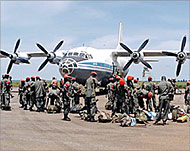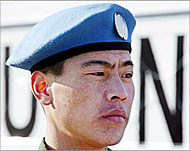Minority tribal militia captures key Congo town
The regional capital of the Ituri district in the Democratic Republic of Congo has been captured by the Union of Congolese Patriots (UPC).
 |
|
Ugandan troops leaving Bunia |
“We can confrim that the UPC has taken most of the town”, said UN spokesman Mamadou Bah on Monday.
Tribal violence in the town of Bunia, in the northeastern Democratic Republic of Congo (DRC), has claimed 32 lives in the past two days, according to the United Nations.
UN troops found 12 dead bodies in the centre of Bunia on Sunday. Five men and four women had gunshot wounds and lacerations, and three tiny babies had had their throats slit.
Clashes between majority Lendus and rival Hema militias have claimed at least 50,000 lives in the past several years, but the latest violence in Bunia, 80 km from the Uganda border, flared again in the past week after the withdrawal of Ugandan troops, leaving militias to fight for supremacy.
The UPC is made up of members of the minority Hema.
“Lots of these militias are drugged,” said UN Congo spokeswoman Patricia Tome. “In certain parts of town there are lots of militiamen, including many child soldiers, with machetes, axes, loot on their backs.”
In spite of Sunday’s killings, Tome said the situation had improved enough in Bunia to allow UN workers to distribute food and water to thousands of refugees left stranded by the fighting in some parts of the town.
The continuing violence has led thousands of civilians to attack the local UN headquarters in protest at the failure of peacekeepers to protect the population.
Pressure on UN
 |
|
Chinese troops make up about a |
The United Nations Mission in the Democratic Republic of Congo (MONUC) said it had about 8,000 people under its protection, with an estimated 30,000 more refugees still in the area. Tens of thousands more have crossed into Uganda.
Calls are mounting for the UN to intervene more forcefully in the worsening crisis. The UN Security Council is due to review the situation on Monday and aid agencies appealed to the council to find troops and resources able to enforce peace.
MONUC has around 620 troops on the ground and expect some reinforcements, but they have been unable to stem the violence and looting as armed militias roam the town.
“For a population of 340,000, MONUC have neither the mandate, troops nor equipment to enforce peace and protect civilians effectively in Bunia,” aid organisation Oxfam said in a statement. “MONUC’s few troops on the ground have taken action, but the situation is beyond their control.”
The South African President and chair of the African Union, Thabo Mbeki, planned to appeal directly to UN Secretary General Kofi Annan to authorise UN troops to use force to defend civilians, his spokesman Bheki Khumalo said in Johannesburg.
Tome said discussions were underway between civil leaders, militia groups and the Congolese Justice Minister, currently in Bunia, to try and resolve the situation.
Tragic history
The DRC’s civil war began in 1998 when Uganda and Rwanda invaded to back rebels fighting to topple the government in Kinshasa.
Laurent Kabila’s government was challenged by Rwanda and Uganda-backed fighters in August 1998, but troops from Zimbabwe, Angola, Namibia, Chad, and Sudan intervened to support Kabila.
Although a ceasefire was signed on 10 July 1999 by the DRC, Zimbabwe, Angola, Uganda, Namibia, Rwanda, and Congolese armed rebel groups, sporadic fighting has continued with various ethnic groups receiving support from different sponsors.
Kabila was assassinated in January 2001 and his son Joseph Kabila was named head of state in the same month. By October 2002, the new president was successful in securing the withdrawal of occupying Rwandan forces from eastern Congo. But Ugandan troops have been slower to leave the country.
Aid agencies say more than three million people have died in the last five years of violence, mostly through war-related starvation or disease.